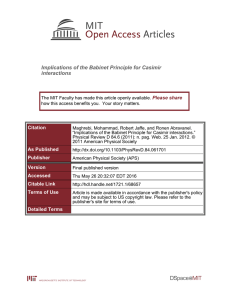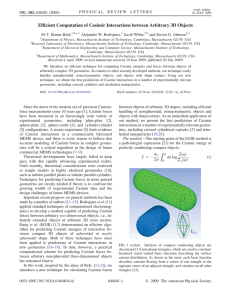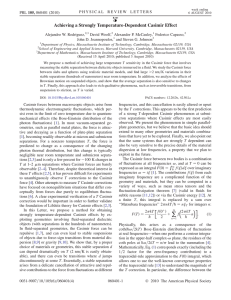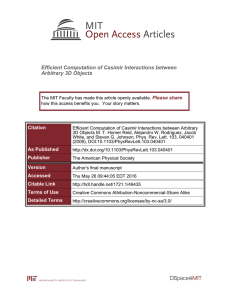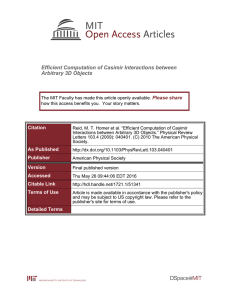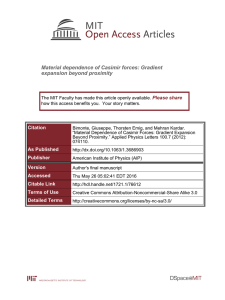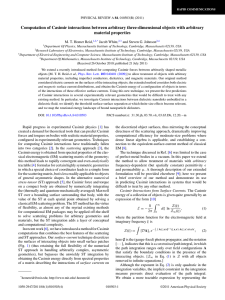Electromagnetic field quantization in the presence of a medium Fardin Kheirandish 1
advertisement
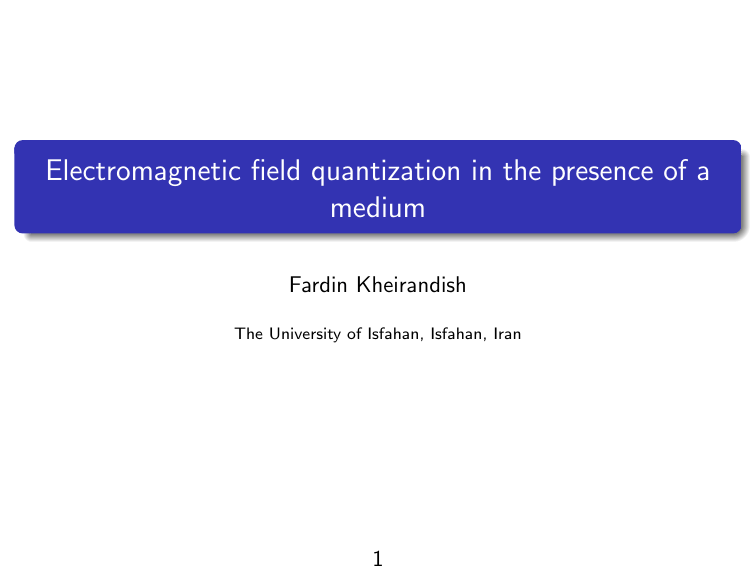
Electromagnetic field quantization in the presence of a
medium
Fardin Kheirandish
The University of Isfahan, Isfahan, Iran
1
Table of contents
1
Introduction
When we quantize EF in the presence of a medium
The main idea: Modeling the medium
Generality of the approach
2
The quantum damped harmonic oscillator
3
Static magnetodielectric medium
4
Electromagnetic field quantization in the presence of a rotating
dielectric
Why we quantize EF in the presence of a medium?
For example in the following problems
Spontaneous emission of atoms close to dielectric surfaces,
Energy level shifts of atoms close to dielectrics,
Static and dynamical Casimir effects,
Propagation of light pulses through a magneto-dielectric medium,
Optical properties of nano-structures, etc.
3
Main idea: Modeling the medium with harmonic oscillators
Hopfield [1], Caldeira-Legget [2, 3], Huttner-Barnett [4], K[5, 6].
B-Bath
Main system
E-Bath
4
Generality of the approach
It can be applied to a general field theory (Scalar, Vector, Tensor,
Spinor) in the presence of a medium or external potentials K[7, 8].
It can be applied to a general system in the presence of dissipative or
amplifying media K[9].
It can be applied to nonlinear media K[10]
Radiation process like Cherenkov radiation K[11]
Methods of open quantum system theory:
Quantum Langevin equation [12]
Lindblad super operator method [13]
Master equation method [14]
Path-integral method [15]
5
The quantum damped harmonic oscillator K[16]
a
b
| n
This region can be modeled by a
collection of harmonic oscillators
| n1
| n2
Final state: no more energy can
be transferred to environment
| 0
6
x
Harmonic oscillator
1 2 1 2 2
ẋ − ω◦ x
2Z
2
1 ∞
+
dω [Ẏω2 − ω 2 Yω2 ]
2 0
Z ∞
+
dω f (x, ω)Yω ẋ
|0
{z
}
L =
Polarization
∂L
p=
= ẋ +
∂ ẋ
Pω =
Z
∞
dω f (x, ω)Yω
0
∂L
= Ẏω
∂ Ẏω
[x, p] = i~, [Yω , Pω0 ] = i~δ(ω − ω 0 )
7
Harmonic oscillator
x̂¨ + ω◦2 x̂ + ∂t
Z
∞
|0
dωf (x, ω)Yω = 0
{z
}
P
¨
Ŷω + ω 2 Ŷω = f (x, ω)x̂˙
r
Ŷω =
~
(âω e −iωt + âω† e iωt ) +
2ω
|
{z
}
Z
t
−∞
dt 0
sin ω(t − t 0 )
˙ 0)
f (x, ω)x̂(t
ω
|
{z
}
Green’s function
Noise or fluctuating field
[âω , âω† 0 ] = δ(ω − ω 0 )
r
Z ∞
~ N
P̂ (x, t) =
dωf (x, ω)
âω e −iωt + âω† e iωt
2ω
0
8
Response function↔ Coupling function
0
∞
Z
χ(t − t ) =
0
f 2 (ω)
sin[ω(t − t 0 )] 7→ f (ω) =
dω
ω
x̂¨ + ω◦2 x̂ + ∂t
Zt
r
2ω
Im[χ(ω)]
π
˙ 0 ) = −P̂˙ N (t) = F̂ N (t)
dt 0 χ(t − t 0 )x̂(t
−∞
0
Example: Set χ(t − t ) = 2γθ(t − t 0 ) then
x̂¨ + 2γ x̂˙ + ω◦2 x̂ = F̂ N (t)
r
~π
N+
f (ω)âω
P̂ (ω) =
ω
1
hP̂ N− (ω)P̂ N+ (ω 0 )i = 2~ Im[χ(ω)] β~ω
δ(ω − ω 0 )
e
−1
9
Hamiltonian: Minimal Coupling Method
X
H=
pi q̇i − L
Minimal coupling K[8]
⇓
(p − P)2 1 2 2 1
H=
+ ω◦ x +
2
2
2
Z∞
dω [Pω2 + ω 2 Yω2 ]
0
Z
P=
∞
dω f (ω)Yω
0
Hint = −pP
10
Fermi’s golden rule
Γ=
2π X
|hf |Hint |0i|2 δ(ω − ω 0 )
~2
f
⇓
The probability rate for transitions |ni → |n ± 1i are given by
Γ|ni→|n−1i =
e β~ω◦
nω◦ π
|f (ω◦ )|2 β~ω◦
,
~
e
−1
Γ|ni→|n+1i =
nω◦ π
1
|f (ω◦ )|2 β~ω◦
,
~
e
−1
where β = kB1T . At T = 0 there is only dissipation. This formalism can be
generalized to amplifying media K[9].
11
Static magnetodielectric medium
Note that electromagnetic field is a collection of harmonic oscillators and
we know how to quantize an oscillator in the presence of its environment
so what follows is a straightforward generalization.
Temporal gauge: A0 = 0 ⇒ E = −∂t A, B = ∇×A
1
1
(∇×A)2
L = 0 (∂t A)2 −
2
2µ0
Z
1 ∞
+
dν [(∂t X)2 − ν 2 X2 ] → elec. properties
2 0
Z
1 ∞
+
dν [(∂t Y)2 − ν 2 Y2 ] → magn. properties
2 0
Z ∞
− 0
dν fij (r, t, ν)X j ∂t Ai → (P · E)
0
Z
1 ∞
+
dν gij (r, t, ν)Y j (∇×A)i → (M · B)
µ0 0
12
Static magnetodielectric medium
Definition of polarizations:
∞
Z
dν fij (r, t, ν)X j ,
Pi (r, t) = 0
0
Mi (r, t) =
1
µ0
Z
∞
dν gij (r, t, ν)Y j
0
Following the same steps for harmonic oscillator we have
Z ∞
fij fkj Ek
N
2
P(r, ω) = P (r, ω) + 0
dν 2
,
ν − ω2
0
Z ∞
gij gkj Bk
1
dν 2
M(r, ω) = MN (r, ω) + 2
,
ν − ω2
µ0 0
13
Static magnetodielectric medium
Define response tensors by:
Z
∞
fij (r, ν)fkj (r, ν)
,
ν 2 − ω2
0
Z
gij (r, ν)gkj (r, ν)
1 ∞
m
dν
,
χik (r, ω) =
µ0 0
ν 2 − ω2
χeik (r, ω) = 0
dν
We can assume f = f t and g = g t , therefore:
f¯(r, ω) =
ḡ (r, ω) =
r
2ω
Imχ̄e (r, ω),
π0
r
2ωµ0
Imχ̄m (r, ω),
π
14
Static magnetodielectric medium
∇×(
1
ω2
· ∇×E) − 2 ¯ · E = µ0 ω 2 PN + iµ0 ω∇×MN
µ̄
c
where
1
, magn. permeability
1 − χ̄m (r, ω)
¯(r, ω) = 1 + χ̄e (r, ω), elec. permittivity
µ̄(r, ω) =
For non magnetic and isotropic matter we have
∇×∇×E −
ω2
(r, ω)E = µ0 ω 2 PN
c2
15
Example 4: Casimir effect
Medium: EM
vacuum field
Main system
16
Casimir effect
Total Lagrangian density:
1
1 ∂A 2
0 (
) −
(∇×A)2
2
∂t
2µ0
Z
1 ∞
∂Xν 2
+
dν [(
) − ν 2 X2ν ]
2 0
∂t
Z ∞
∂A ¯
− 0
dν (
)·f ·X
∂t
0
L =
Wick rotation:
it = τ → dt = −idτ, ∂t = i∂τ
Z
iS = i
Z
t
Z
dt L →
dr
0
Z
0
17
β
dτ LE
dr
Casimir effect
Euclidean Lagrangian density:
LE
1
∂2
1
= − A · (−0 2 + ∇×∇×) ·A
2
∂τ
µ
|
{z 0
}
−
1
2
D̄
2
∂
∞
Z
dν X · (− 2 + ν 2 ) ·X
| ∂τ{z
}
0
B̄
∞
Z
+ 0
0
Z
Z=
D[A]
Y
∂X
dν A · f¯ ·
∂t
D[Xν ] e SE [A,{Xν }] = tr e SE [A,{Xν }]
ν≥0
18
Casimir effect
Z
=
Z Y
1
−
D[Xν ]D[A] e 2
Z
Z
β
dτ [A · D̄ · A + A · J]
dr
0
ν≥0
1
−
× e 2
Z
β
Z
∞
Z
dν Xν · B̄ · Xν
dτ
dr
0
where
0
Z
J=
∞
dν f¯ ·
0
19
∂Xν
∂τ
Casimir effect
0
∞
X
A(r, τ ) =
[An (r)e −iωn τ + A∗n (r)e iωn τ ]
n=0
0
∞
X
Xν (r, τ ) =
[Xν,n (r)e −iωn τ + X∗ν,n (r)e iωn τ ]
n=0
(1)
where ωn =
2πn
β
are Matsubara frequencies for bosonic fields.
Z
β
e i(ωn −ωm )τ dτ = βδnm
0
20
Casimir effect
Z
=
Z Y
D[Xν,n ]D[X∗ν,n ]
n,ν≥0
1
2
Z
1
× e 2
Z
−
× e
−
Y
D[An ]D[A∗n ]
n≥0
∞0
dr
X
(An · β D̄ · A∗n + A∗n · β D̄ · An + An · J∗n + A∗n · Jn )
n=0
∞
Z
dr
dν (X∗ν,n · β B̄ · Xν,n + Xν,n · β B̄ · X∗ν,n )
0
Now we integrate over EF degrees of freedom.
21
Casimir effect
0
Z
Y
=
−1
(det[β D̄])
Z Y
n≥0
|
×
n,ν≥0
{z
}
partition function of free EF
Z
Z ∞
1
dr
dν (X∗ν,n
−
2
0
e
Z Z
× e
D[Xν,n ]D[X∗ν,n ]
drdr0 J∗n (r) ·
· β B̄ · Xν,n + Xν,n · β B̄ · X∗ν,n )
1
Ḡ · Jn (r0 )
β
where Ḡ0 = D̄ −1 is the free EF dyadic Green’s function D̄ Ḡ0 = I.
22
Casimir effect
Now we integrate over matter degrees of freedom in a similar way to find
0
Z
=
Y
0
−1
(det[β D̄])
n≥0
|
Y
(det[β B̄])−1
n≥0
{z
}|
0
ZEF
{z
0
ZM
}
0
×
Y
(det[1 + ωn2 GB f¯t · Ḡ0 · f¯])−1
n≥0
|
{z
Zeff
Now using ln[det Ô] = tr ln[Ô] we find
23
}
Casimir effect
0
ln Zeff = −
∞
X
tr ln[1 + ωn2 GB · f¯t · Ḡ0 · f¯]
n=0
ln(1 + x) =
∞
X
(−1)m−1
m=1
Z
χik (r, ω) =
∞
dν
0
xm
m
fij (r, ν)fkj (r, ν)
ν 2 − ω2
χ̄(r, iωn ) = trν [GB (iωn )f¯(r)f¯t (r)]
24
Casimir effect
0
ln Zeff = −
∞
X
n=0
tr|i,ri ln[1 + χ̄(iωn ) · Ḡ0 (iωn )]
{z
}
|
Ḡ ·Ḡ0−1
The free energy is defined by
0
F = −kB T ln Zeff = kB T
∞
X
tr|i,ri ln[1 + χ̄(iωn ) · Ḡ0 (iωn )]
n=0
In zero temperature
R∞
0
dζ
2π
Z
F =
0
↔ kB T
∞
P∞ 0
n=0
dζ
tr ln[1 + χ̄(iζ) · Ḡ0 (iζ)]
2π
25
Rotating Dielectric
0
T0
0t
T
ρ0 = ρ, ϕ0 = ϕ − ω0 t, z 0 = z, t 0 = t,
∂ρ0 = ∂ρ , ∂ϕ0 = ∂ϕ , ∂z 0 = ∂z , ∂t 0 = ∂t + ω0 ∂ϕ ,
26
Rotating Dielectric
1
1
0 (∂t A)2 −
(∇×A)2
2
2µ0
Z
1 ∞
+
dν [(∂t X + ω0 ∂ϕ X)2 − ν 2 X2 ]
2 0
Z ∞
− 0
dν fij (ν, t)X j ∂t Ai
0
Z ∞
+ 0
dν fij (ν, t)X j (v × ∇×A)i
L =
0
Coupling tensor
Coupling tensor is now time-dependent
fxx (ν) cos(ω0 t) fxx (ν) sin(ω0 t)
0
0
fij (ν, t) = −fyy (ν) sin(ω0 t) fyy (ν) cos(ω0 t)
0
0
fzz (ν)
We assume fxx = fyy in body frame.
Lagrangian can be generalized to a covariant one including the magnetic
properties.
28
Main equation
Main equation
[∇×∇× −
ω2
ω2
I
−
D̃ · χee (ω, −i∂ϕ ) · D] · E = µ0 ω 2 D̃PN
c2
c2
1
1
v × ∇× and D̃ = 1 + iω
∇×v×. The presence of
where D = 1 + iω
operators D, D̃ in this recent equation makes it a complicated equation.
For small velocity regime (v /c 1) we can set approximately D, D̃ ≈ 1
and in high velocity regime numerical calculations may be applied.
29
Fluctuation-Dissipation relations
hPiN (r, ω)PjN† (r0 , ω 0 )i = 4π0 ~ δij Γij (ω, −i∂ϕ )δ(r − r0 )δ(ω − ω 0 )
where Γij are defined by Γxz = Γzx = Γyz = Γzy = 0,
Γzz (ω, m) = 2Im[χ0zz (mω0 − ω)]aT (mω0 − ω),
Γxx (ω, m) = Im[χ0xx (mω0 − ω+ ]aT (mω0 − ω+ )
+ Im[χ0xx (mω0 − ω− ]aT (mω0 − ω− ),
Γxy (ω, m) = i Im[χ0xx (mω0 − ω− ]aT (mω0 − ω− )
− i Im[χ0xx (mω0 − ω+ ]aT (mω0 − ω+ ),
and aT (ω) = coth(~ω/2kB T ) = 2[nT (ω) + 21 ]
30
Hamiltonian
Z
H =
dr
V
+
1
2
1
1
(P − D)2 +
(∇×A)2
20
2µ0
∞
Z
dν [Q2ν + ν 2 X2ν ]
Z0
− ω0
∞
dν Qν · ∂ϕ Xν − P · (v × ∇×A)
0
(2)
Interaction:
Z
Hint
= −
dr[P(r, t) · E(r, t)
Vs
+ P(r, t) · (v × ∇×A(r, t))],
Z
= −
dr[P(r, t) · E(r, t) + (P(r, t) × v) · B(r, t)]
V
(3)
31
The radiated power
The radiated power can be written as
Z
drh[∂t P − ∇×(v × P)] · (E + v × B)i
hPi = −
V
where |i = |vacuumiT0 ⊗ |matter iT
is the tensor product of initial
thermal states of the electromagnetic and matter field which are supposed
to be held at temperatures T0 and T respectively. For small bodies or
small velocities we have
Z
hPi = −
drh∂t P · Ei.
(4)
Vs
32
The radiated power
For an extended body with azimuthal symmetry and small velocity we have
Z
Z ∞
~
hPi =
dr
dωω 3 [aT (ω − ω◦ l̂z ) − aT◦ (ω)]
2πc 2
−∞
Imχ◦zz (ω − ω◦ l̂z )Im Gzz (r, r0 , ω) + Imχ◦xx (ω − ω◦ l̂z )
×Im[Gxx (r, r0 , ω) + Gyy (r, r0 , ω)] cos(ϕ − ϕ0 )| r0 →r
where l̂z = −i∂ϕ , and we used the symmetry properties of tensors
Gij (r, r0 , ω) and Γij (ω, −i∂ϕ ).
Spherical Drude particle: PRL 105, 113601 (2010)
t
ω(t) = ω0 e − τ
τ (Stopping time) =
(~c)3 ρa2 σ◦
π (kb T◦ )4
ρ = Particle density
Graphite particles are abundant in interstellar dust [F. Hoyle and N. C.
Wickramasinghe, Mon. Not. R. Astron. Soc. 124, 417 (1962)
σ0 = 2.3 × 104 (2.0 × 105 ), a = 10(100)nm,
For a = 10nm, T0 = 1000K → τ ≈ 1Day
For a = 10nm, T0 ≈ room temperature → τ ≈ 1Year
For a = 100nm, T0 = 2.7K → τ ∼ 0.6 billion years
34
[1] J. J. Hopfield, Phys. Rev. 112, 1555 (1958).
[2] A. O. Caldeira and A. J. Leggett, Phys. Rev. Lett. 46, 211 (1981).
[3] A. O. Caldeira and A. J. Leggett, Ann. Phys. (New York) 149, 374
(1983).
[4] B. Huttner and S. M. Barnett, Phys. Rev. A 46, 4306 (1992).
[5] F. Kheirandish and M. Amooshahi, Phys. Rev. A 74, 042102
(2006).
[6] F. Kheirandish and M. Soltani, Phys. Rev. A 78, 012102 (2008).
[7] F. Kheirandish and S. Salimi, Phys. Rev. A 84, 062122 (2011).
[8] F. Kheirandish and M. Amooshahi, Int. J. Theo. Phys., Vol. 45,
No.1 (2006).
[9] E. Amooghorban, M. Wubs, N. A. Mortensen, and Fardin
Kheirandish, Phys. Rev. A 84, 013806 (2011).
35
[10] F. Kheirandish, E. Amooghorban and M. Soltani, Phys. Rev. A
83, 032507 (2011).
[11] F. Kheirandish and E. Amooghorban, Phys. Rev. A 82, 042901
(2010).
[12] W. T. Coffey, Yu. P. Kalmykov and J. T. Waldron, and electrical
engineering, 2nd edition The quantum Langevin equation: with
applications to stochastic problems in physics, chemistry, Copyright
(2004) by World Scientific Publishing Co. Pte. Ltd.
[13] Heinz-Peter Breuer and Francesco Petruccione, The theory of
open quantum systems, Oxford University Press (2002).
[14] Ulrich Weiss, Quantum dissipative systems, (3rdEdition) Series in
Modern Condensed Matter Physics-Vol. 13 Copyright (2008) by World
Scientific Publishing.
[15] R. P. Feynman and F. L. Vernon, Jr., Ann. Phys. 281, 547-607
(2000).
36
[16] F. Kheirandish and M. Amooshahi, Mod. Phys. Lett. A, Vol.20,
No.39 (2005) 3025-3034.
37





